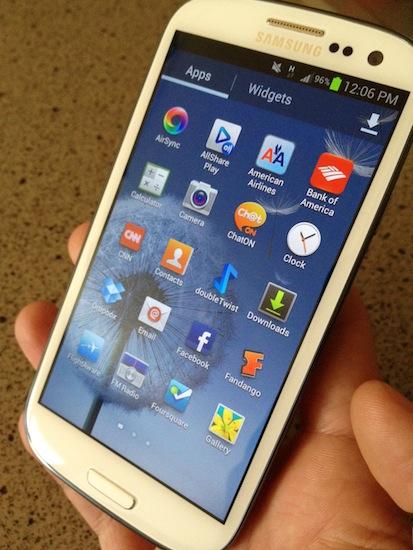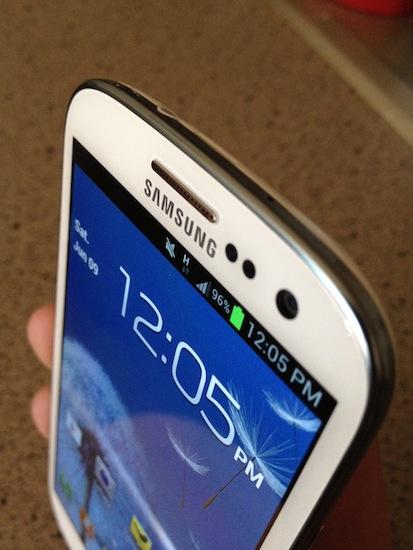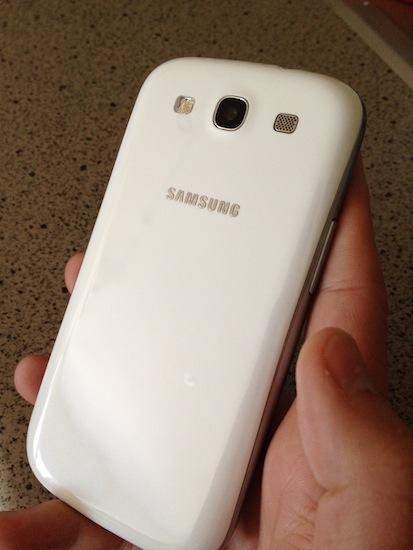
I keep returning to the same train of thought: with the Galaxy S III, Samsung has been successful in completely consumerizing Android. And they have a powerful brand platform. The Galaxy S III is a huge marketing win for Samsung, as it provides a consistent branding message across the world, and across the five largest wireless carriers in the US. Gone for now are carrier-cultivated names like the Samsung Galaxy S II, Epic 4G Touch. Verizon, AT&T, Sprint, T-Mobile, and US Cellular customers will know the flagship device as the Samsung Galaxy S III.
Yes, the overarching theme that I come away with after working with the Samsung Galaxy S III for a couple of days is the very thing that Android purists and fans will hate most: this is the first Android device that I can say without a doubt is ready for the mainstream user. I'm referring solely to the other 99 percent of us; those that want a consistent, fluid experience with some great features that can be accessed without rooting or tweaking the phone. Thanks to a solid combination of specs and ease-of-use, I could safely recommend this phone to the power user, the social media buff, the media junkie, and the first-time smartphone buyer. And at the end of the day, most of them would be very pleased with the package.
I've been working with the international Galaxy S III, which offers a 1.4 GHz quad-core Exynos processor, 1 GB of RAM, a 4.8-inch Super AMOLED HD display, 8-megapixel camera with 1080p HD video recording, a 1.9-megapixel front-facing camera, 2,100 mAh battery, Android 4.0 with a new build of TouchWiz, and HSPA+ 21 Mbps connectivity that'll work on AT&T in the US. It directly competes with other Android flagships like HTC's One X and EVO 4G LTE, and is coming to five carriers in the US beginning on June 21st. The US build will swap out the Exynos chip for a 1.5 GHz dual-core Snapdragon S4 CPU, and will be bundled with 2 GB of RAM and 4G connectivity (LTE or HSPA+, depending on your carrier).
- The Galaxy S III launches amidst some tough competition; most notably, HTC's One X. HTC's flagship comes very close and offers a great (albeit different) user experience, but from a software standpoint, it still needs some polish around the edges. I get the vibe that HTC is trying to double dip between the tech and mainstream consumer crowds with Sense 4, whereas Samsung is gunning for the mainstream crowd, territory that Apple has long dominated. HTC's approach is great for those of us that enjoy tinkering with our smartphones, and I give the company credit for creating a less polarizing UI that will appeal to both mainstream users and tech geeks (a historically strong demographic for the company). As for HTC's "appeal to everyone" versus Samsung's "appeal to the mainstream" strategy, it's anyone's guess as to which is more successful long-term, but I'd wager that Samsung's distribution agreements with the five US carriers will place it in a very lucrative position that HTC hasn't (yet) been able to enjoy with their flagship.
- The international Samsung Galaxy S III is available in 16, 32, and 64 GB variants and can be purchased in pebble blue or marble white. If you can't wait for the US variants, it's available now for a lot of money at online retailers like Negri Electronics. I've been working with the marble white model, though I think I'm partial to the pebble blue. AT&T's exclusive red model sounds really appealing, provided it's a dark red. Both phones come in at 8.6mm thin and weigh 5.6 ounces.

- The design language is typical Samsung, as you'd expect; all variants are glossy and made of plastic. The volume rocker is on the left side; power button is on the right; 3.5mm headphone jack is up top; and the microUSB charging port is on the bottom. Those against non-removable batteries will find the Galaxy S III to be appealing; the phone's 2,100 mAh battery and microSD card slot can easily be accessed by removing the back cover.
- More on the design. Rewind back to the global announcement day, and I was on a plane, headed from San Francisco to London. Thanks to a series of meetings and events that I needed to attend earlier in the week, I hadn't had the time to follow-up on every news article. So as such, I missed most of the final rumor posts about the Galaxy S III. The Galaxy S III was placed in my hand at a meeting that morning, prior to the circulation of press releases and associated images. So unlike many of the people reading this, I held the actual phone before I saw the press images, and as such, my opinions of the design were formulated in a different manner. I see a lot of criticism about the Galaxy S III's look on the web, and while some of it can be chalked up to Samsung's plastic design language, I'm seeing a number of comments against the design in itself. Design preferences are obviously subjective, but if you're at all on the fence, I'd strongly advise checking it out in a retail store. The press images don't do an adequate job of conveying the overall design and feel of the smartphone in the hand.
- Connectivity has been strong thus far. With the international version, you lose 4G LTE connectivity in place of HSPA+ 21 Mbps (which works well on AT&T), but gain slightly better battery life as a result. Working with a non-AT&T branded device (read: no always-on-regardless-of-speed "4G" indicator) is testament to how often the network switches between HSPA+ and other 3G variants, but when AT&T's HSPA+ network is in action, speeds are zippy. In testing in Charlotte, San Francisco, and Phoenix, I noticed download speeds between 3 and 6 Mbps, with bursts as high as 7.1 Mbps.

- So far, battery life has been exceptional. Despite powering a 4.8-inch HD display, I've been able to easily make it through the day, even while throwing it some tough curveballs. Yesterday, I removed the phone from the charger at 4:00 AM EST for a full day of travel and meetings in San Francisco. With two hours of calls; an estimated 200 text messages; reading several emails and responding to approximately 25 from the phone; light web browsing; roughly two hours of music playback while traveling; and downloading a few apps; I was able to make it until just after 7:00 PM PST. Your mileage may vary depending on the level of customization you apply to the phone (obviously, things like live wallpapers, news, and weather all take a toll on the battery), but it's a strong contender in the battery life department. While I'm still running final tests, it easily goes against the international Samsung Galaxy Note and appears to best the international HTC One X.
- The level of customization and things you can do with the Galaxy S III is impressive. Instead of making it "just another Android phone," the Galaxy S III offers a ton nifty customizations to the software that are intended to make the device easier to use. Some of my favorites:
- Integrated battery percentage indicator
Something I've been waiting for on Android for years. Without rooting, you have the option of a battery percentage indicator at the top of the display. This is a feature I use on every single one of my smartphones (and get irritated when I don't have the option - ahem, Windows Phone), so the ability to access it without downloading a separate widget is incredibly useful.
- Tap to return to the top of a list
While viewing a list (I use it most often in Contacts), you can tap two of your fingers on the top of the phone, and the Galaxy S III will scroll to the top.
- Missed call and text vibrate notification
I chalk this up to receiving 200-300 emails a day and to a lesser extent, my desire to always make sure my email and text message folders are clear. But this is an incredibly useful feature. When enabled, you can pick up the phone and it will emit a quick vibration if you have any missed calls or text messages. Sure, there's the notification light, but the vibrate offers an extra touch and saves that half a second between waiting for the light to illuminate. And a bunch of half-seconds equate to at least 30 more seconds I have throughout the day. Yep, that would be my 24-hour media mindset talking.
- Voice features
You'll see this one on full display in the review, but it's a cool little feature that I've really been enjoying. You can assign the phone to recognize a specific voice command at the unlock screen and perform certain tasks. For example, I press the power button to access the unlock screen, say "play music," and it automatically starts up my music. I also use "check text messages" quite a bit, which as you would expect, is programmed to take me directly to my Messages app. It's important to note that you can make the voice command your own; if you want to direct Galaxy S III to show you missed calls when you say "Aaron Baker rocks my socks," you can program it appropriately.
Small software features and tweaks along with powerful specifications make this device a fantastic upgrade to the Galaxy series, and prove that Samsung is thinking outside of the Android box. This is the kind of Android experience that I've hoped to see for years: powerful technology with the flexibility of Android and iOS-like fluidity.